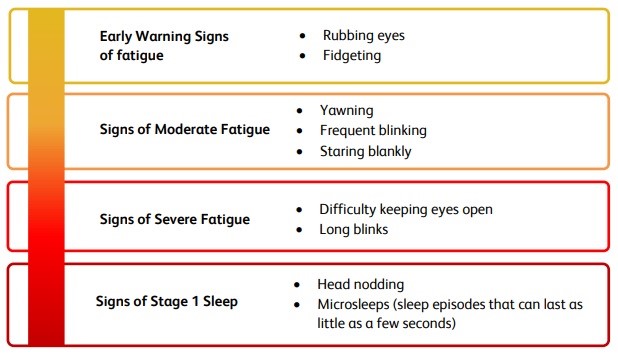Guidance for companies in the rail industry.

Purpose of this guidance
1.1 This guidance provides an approach for companies in the rail industry to manage their fatigue risk and provides advice on good practice. However, the approach and content may be relevant to other safety critical industries that do not have industry specific guidance and the document builds on the more general guidance applicable to all industries, including rail, in the Health and Safety Executive’s (HSE’s) guidance publication HSG256 ‘Managing shift work – health and safety guidance’.
1.2 This guidance supersedes the Office of Rail and Road’s (ORR’s) guidance on Managing Rail Staff Fatigue published in 2012. The revision has been undertaken in light of the need to update and modernise the previous guidance. The revised guidance does not introduce any new policy positions. However, for simplification, the document integrates what is known as the ROGS 9 stage approach provided in the 2012 guidance to provide an overarching approach to managing rail staff fatigue. It should be noted that the ROGS 9 stage approach is not a specific legal requirement set out by ROGS, nor is it a general ROGS policy principle or an inherent part of ROGS. Furthermore, as HSE has moved away from using the POPMAR (Policy, Organising, Planning, Measuring performance, Auditing and Review) model of managing health and safety to a ‘Plan, Do, Check, Act’ approach, we have revised this guidance accordingly. Finally, ORR’s Fatigue Factors, or good practice guidelines, have been included.
1.3 This document reflects significant elements of the legislation that duty-holders need to be aware of. However, it does not seek to cover every aspect of the legislation. It is the responsibility of dutyholders to ensure that they are compliant with the law. This guidance does not place additional burdens on dutyholders or introduce new duties.
1.4 Following this guidance will normally be sufficient to demonstrate compliance with the law. Should you choose to take an alternative approach then you should ensure that it is equally effective to achieve compliance. Railway Inspectors seek to secure compliance with the law and may refer to this guidance as illustrating good practice.
1.5 The guidance is aimed at companies and individuals who have responsibility for managing fatigue in railway staff, including those who have control of safety critical work under regulation 25 of the Railways and Other Guided Transport Systems (Safety) Regulations 2006 (ROGS). This Regulation is detailed in Section 2.
What do we mean by fatigue?
1.6 There is no single agreed definition of fatigue, but for the purposes of this guidance, fatigue will be considered as ‘a state of reduced mental or physical capability resulting from sleep loss or extended wakefulness, disruption to circadian rhythms (the ‘internal body clock’), workload (mental and/or physical activity) and/or prolonged working that can impair alertness and the ability to perform safely and/or effectively’. A fatigued person will be less alert, less able to process information, will take longer to react and make decisions, and will have less interest in working compared to a person who is not fatigued.
1.7 Alertness, as well as or instead of fatigue is increasingly being referred to by sectors of the rail industry. The American Psychological Association Dictionary of Psychology (2018) defines alertness as ‘the state of being awake, aware, attentive, and prepared to act or react’. Gurubhagavatula and others (2021) define it as ‘the ability to direct and sustain attention, which is influenced by prior sleep and sleep loss, circadian rhythmicity, time on task (duration of continuous work), and other factors. Alertness manifests as the ability to maintain the attention necessary to perform a task at a specified level. Sleepiness is associated with reduced alertness’. Whilst it is for individual dutyholders to determine how they manage fatigue and alertness it is important to note that reduced alertness occurs at a point along the fatigue continuum. If staff are too fatigued to work, they should continue to report themselves as such. Furthermore, whilst alertness focuses on attention and vigilance it does not necessarily cover the health implications of fatigue which are also important to address for good health and safety.
1.8 Some physical signs of fatigue (taken from Network Rail’s guide on Fatigue Reduction: Stay Alert. Stay Safe) are outlined in Figure 1.1.
Figure 1.1 Physical Signs of Fatigue

Source: Network Rail’s Stay Alert, Stay Safe, Issue 5: October 2021
1.9 Fatigued staff may not adequately perceive risk, and may tolerate risks they would usually find unacceptable, accepting lower standards of performance and safety. Staff communication, monitoring and co-ordination activities are adversely affected by fatigue. People can often be completely unaware of the extent to which their performance is being reduced by fatigue and may be unaware of lapses in attention or even briefly ‘nodding off’.
1.10 Fatigue can be hard to detect in staff unlike other causes of temporary mental impairment such as drugs and alcohol. As yet there is no ‘blood test’ for fatigue, although research funded by the Office of Road Safety in Australia is attempting to develop a blood-based test. The difficulty in detecting fatigue makes it a particular concern in any safety critical work.
1.11 Fatigue increases the likelihood of errors and adversely affects performance (HSE Guidance publication HSG256, 2006), especially in tasks requiring:
- vigilance and monitoring
- decision making
- awareness
- fast reaction time
- tracking ability
- memory
1.12 Various factors contribute to fatigue, generally by reducing sleep duration, extending hours awake or disrupting the timing of sleeping and waking periods. Causes of fatigue include:
- Work related factors e.g. timing of working and resting periods, length and number of consecutive work duties, intensity of work demands, work environment.
- Individual factors e.g. lifestyle, age, diet, medical conditions, drug and alcohol use, which can all affect the duration and quality of sleep.
- Environmental factors e.g. family circumstances and domestic responsibilities, adequacy of the sleeping environment.
1.13 HSE carried out a series of inspections on fatigue management of train drivers and identified the following factors that might affect the onset of fatigue:
- repetitive routes
- long night turns
- insufficient rest before starting a night shift after working an early shift
- high vacancy levels
- very short turnaround time provided
- poor timing of meal breaks in early shifts
- variations in start time of spare turns
- not including training days within the roster
1.14 Research in the rail industry (McGuffog and others, 2005 and Robertson and others, 2010) has identified similar factors across safety-critical roles that contribute to an increased likelihood of fatigue: long periods of duty, time of day (night duties and early starts), the timing and duration of breaks (e.g. too early or too late in the shift, or a single long break rather than shorter, more frequent breaks), consecutive duties, and inadequate recovery time.
1.15 Although employers clearly have control over work related factors, later sections of this guidance provide advice on how employers can help ensure that fatigue management arrangements also address individual and environmental factors, so far as it is reasonably practicable. It is important to emphasise though that employees themselves have their own part to play in obtaining sufficient sleep, and in making their employer aware of any fatigue concerns.
Why is managing fatigue important?
1.16 Failure to manage rail staff fatigue properly can have disastrous consequences. Staff fatigue caused by excessive overtime was identified as a contributory factor in the 1988 Clapham Junction collision which killed 35 people. ORR has identified 17 Rail Accident Investigation Branch (RAIB) recommendations specifically concerning fatigue arising from accidents and incidents between 2010 and 2022; however, given that RAIB investigates only a proportion of accidents and incidents, fatigue was likely a causal or contributory factor to a significantly larger number. Fatigue is identified as a factor in twenty-one percent of high-risk rail incidents (Rail Safety and Standards Board (RSSB), 2022). There is mounting evidence that working long weekly hours over long periods increases the risk of accidents and incidents (Dembe and others, 2005).
1.17 Being awake for around 17 hours has been found to produce impairment on a range of tasks equivalent to that associated with a blood alcohol concentration above the drink driving limit for most of Europe. Being awake for 24 hours produces impairment worse than that associated with a blood alcohol concentration above the legal limit for driving on the UK’s roads (Dawson and Reid 1997).
1.18 Additionally, the incidence of health problems such as sleep, gastrointestinal and cardiovascular disorders has been estimated to be greater in shift workers than day workers (Costa 2003; Knutsson 2003; Harrington 2001). Based on population studies, shortened sleep increases a person’s chance of getting a chronic disease (Itani and others, 2017). The Working Time Society, as commissioned by the International Commission on Occupational Health, developed a consensus statement citing strong evidence linking shiftwork and negative health outcomes, such as cardiovascular diseases, gastrointestinal and metabolic disorders, e.g. type 2 diabetes (Moreno and others, 2019). The International Agency for Research on Cancer (IARC) concluded that shift work which involves circadian disruption is ‘probably’ carcinogenic to humans (IARC 2010). The difficulties that shift workers face in maintaining social relationships and activities can also influence individuals’ health.
1.19 In addition to increasing the risk of accidents, incidents and ill-health, fatigued staff increase an employer’s costs. It has been estimated that sleep-related accidents could cost UK companies some £115-240 million per year (Folkard, 2000). ORR’s successful prosecution of ‘Renown Consultants Limited’ in 2020 on three charges relating to their failure to manage fatigue risks resulted in a £450,000 fine for the company as well as £300,000 in costs. RAND Europe estimated that lack of sleep would cost the UK economy £30 billion in 2020, in mortality and reduced productivity (RSSB, 2020). Fatigue makes expensive mistakes more likely, reduces productivity and morale, and increases absenteeism (Dawson and others, 2000). Thus, there are sound financial, as well as legal and moral, reasons to manage fatigue properly.

